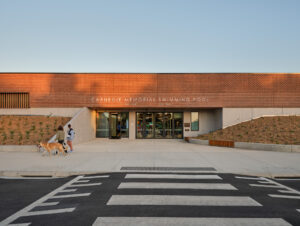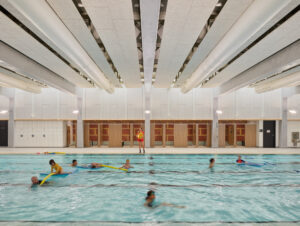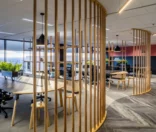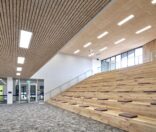Carnegie Memorial Swimming Pool, Carnegie VIC
Background
Since 1966, the Carnegie Memorial Swimming Pool has been a cherished cornerstone of its Melbourne community – a place of seasonal swimming, recreational rituals and precious collective memory. And so, when the time came to modernise the facility, Glen Eira City Council’s vision was one of sensitive transformation that honoured that legacy.
In response, this respectful design by CO.OP Studio preserves the structure’s historic heritage and emotional resonance while introducing modern amenities designed to foster its beloved community for generations to come. Deliberately juxtaposing the harsh vernacular of large, protruding and impersonal leisure centres, the expanded structure, housing indoor pools, a spa, a café and program rooms, is strategically buried into the landscape. Densely planted mounds soften the transition between the building and the surrounding park, allowing the detailed red-brick mass to gently emerge from its context like an intimate retreat.
“Set within parklands, the site is surrounded by residential streets that the original red-brick pavilion receded into,” explains Nick Cini, Design Director at CO.OP Studio. “Despite more than tripling the size of the built footprint, the new, longer, taller built form achieves the same sense of integration.”
Guided by the imperative to harness the site’s nostalgia, the original structure’s key features were thoughtfully retained or adapted to allow visitors to experience the spatial memory of this essential facility. Design gestures celebrating this legacy – like brickwork cladding and the 1950s-inspired metal trusses – are interwoven with the project’s commitment to sustainability and inclusivity, yielding a high-performing space that’s sympathetic towards the environment, while nurturing its community’s well-being, soul and sense of connection.
Challenge
This architectural duality presented a multifaceted challenge: creating a welcoming space that honoured its nostalgic roots, while delivering a modern aquatic centre capable of achieving a landmark 6-Star Green Star rating. Primarily designed for commercial and residential typologies, the Green Star certification pathway is challenging for facilities of this type due to their inherently high energy consumption and year-round, all-day heating operation. As such, the project team needed to explore a broad spectrum of sustainable design decisions to pursue the certification.
As part of this holistic strategy, acoustic performance emerged as an essential consideration. Due to the combination of large, open volumes, hard surfaces and high ambient noise levels that tend to create reverberation, aquatic centres are notoriously difficult acoustic environments. To create a comfortable space for visitors and ensure the project achieved the desired Green Star rating, it was paramount to integrate high-performing acoustic solutions that could withstand the unique atmospheric conditions of an indoor aquatic environment.
“Carnegie Memorial Swimming Pool achieving a 6-Star Green Star design rating and the highest score in Australia for an aquatic centre to date, highlighting the project’s commitment to environmental sustainability,” Nick Cini, Design Director at CO.OP Studio.
Solution
To bring this ambitious vision to life, the project team conceived a comprehensive sustainable design strategy that integrated solutions across a range of categories, including all-electric operation powered by a 240KVA solar array, a commitment to biodiversity and an exemplary approach to thermal insulation. From an indoor environment quality perspective, ensuring acoustic comfort became essential, and, as part of a broader acoustic design, the project team specified Himmel’s signature Troldtekt® White Ultrafine, whose acoustic performance contributed to achieving the desired Green Star 6-star rating.
This cement-bonded wood wool solution offers a distinct fusion of durability, acoustic performance and environmental credentials, and, in this instance, the team opted for Troldtekt® White Ultrafine, which is well-suited to environments that demand exceptional sound absorption. “This was a key selection to ensure the acoustic performance of the facility created quiet and peaceful spaces whilst performing well in an aquatic environment,” Nick explains.
Specified in a gentle white hue, the acoustic panels’ natural wood texture and finish formed a cohesive part of the light palette of sandy whites, while their sustainability credentials further reinforced their suitability for this environmentally-driven project. Made with FSC® or PEFC™ certified wood, the recyclable Troldtekt® White Ultrafine panels are also Cradle to Cradle Gold certified and come with a detailed International Environmental Product Declaration (EPD), supporting the pursuit of the desired Green Rating with their acoustic performance and providing a verified environmental profile to match.
Alongside Troldtekt® White Ultrafine, the team selected the M750 Top Hats, a part of the Rondo ceiling and wall framing system. Made from high-quality steel, the product also carries an EPD and Rondo’s Level 2 certification from Steel Sustainability Australasia, further highlighting the project’s commitment to sustainability. As a result, CO.OP Studio’s comprehensive design masterfully blends past, present and future to ensure that the cherished legacy of the Carnegie Memorial Swimming Pool can continue for decades to come, while setting a new industry benchmark for sustainable public architecture.
“Close collaboration with the client and broader team has resulted in Carnegie Memorial Swimming Pool achieving a 6-Star Green Star design rating and the highest score in Australia for an aquatic centre to date, highlighting the project’s commitment to environmental sustainability,” Nick states proudly. “Now a year-round asset, the reimagined Carnegie Memorial Swimming Pool blends nostalgic elements with contemporary needs to create a high-performing space that serves to improve and enhance the health and well-being of its local community and environment.”
Architect: CO.OP Studio
Photography: Tom Roe








